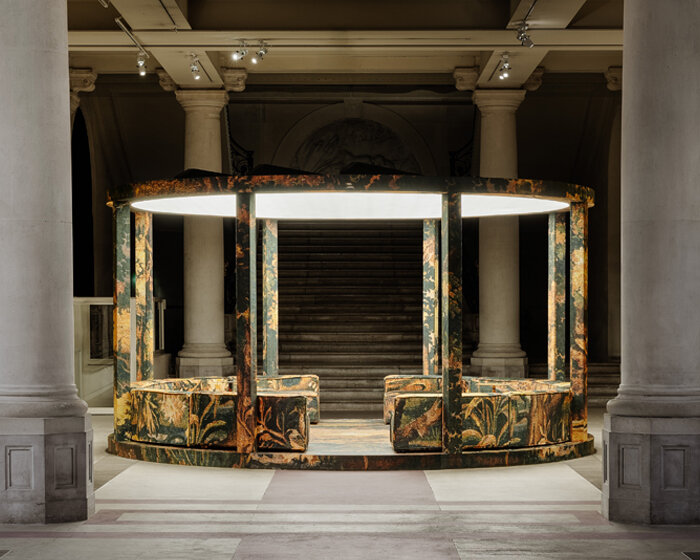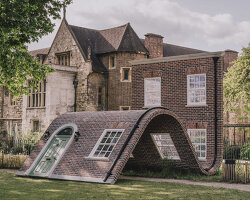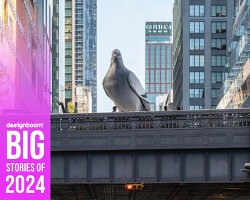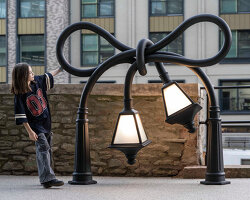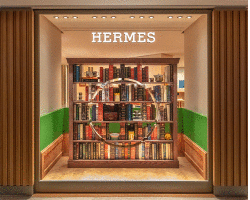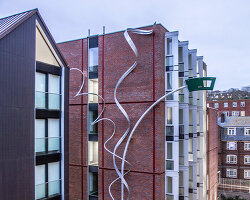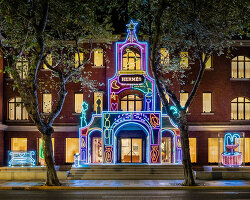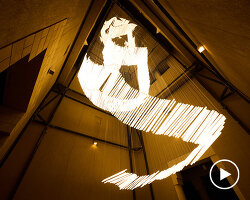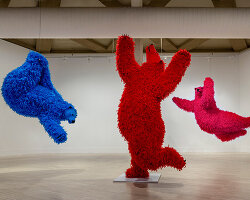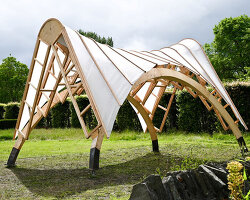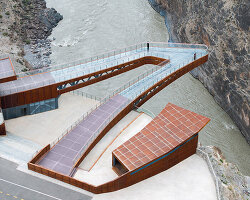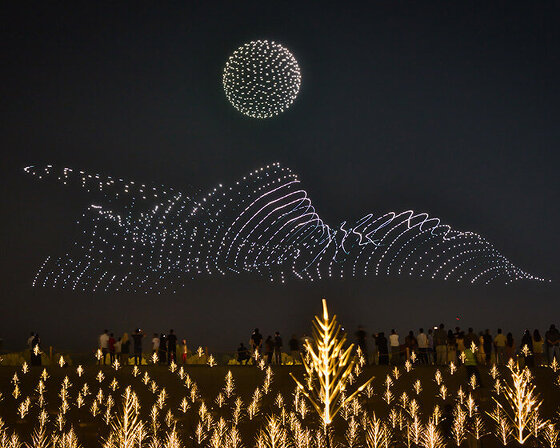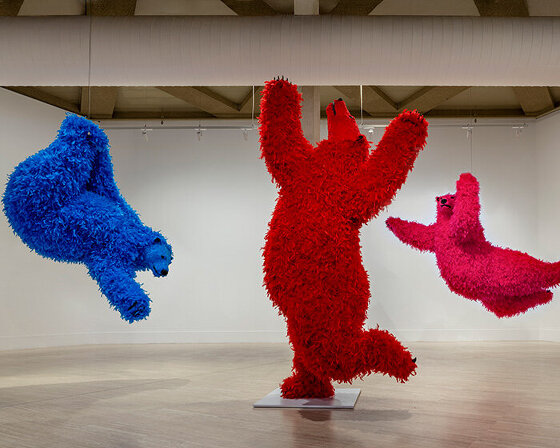alex chinneck on the looping boat, his most complex work yet
British artist and sculptor Alex Chinneck is days away from unveiling The Looping Boat, his most complex installation to date. Seemingly floating on the Sheffield & Tinsley Canal, the artwork takes the form of a sculptural boat whose body, made of rolled steel, behaves in an extraordinary way, performing a six-meter-high and thirteen-meter-long, gravity-defying, aerial loop-de-loop. Chinneck is painting it in traditional canal boat colors and will engrave it with sign-writing that celebrates Sheffield’s industrial heritage and historic waterways. ‘It’s very much nestled into its situation, and it’s really unpretentious,‘ the artist tells designboom. Positioned between locks 4 and 5, the waterway will serve as a gallery space for the sculpture, enabling the dramatic looping hull to be viewed from 180 degrees. The canal, which is looked after by the nation’s waterways charity Canal & River Trust, will also be used to transport sections of the artwork to the site by boat.
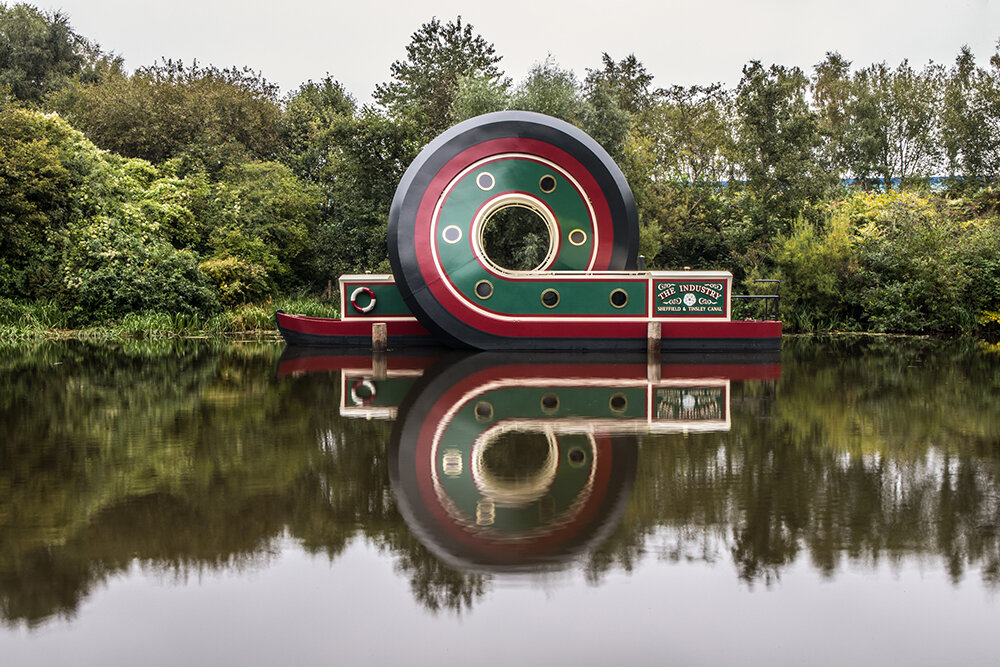
all images © Marc Wilmot | music (header video) by Cosmo Sheldrake
expanding interventions across sheffield
Alex Chinneck has been working on The Looping Boat since 2016. During that time, the artist installed two temporary public artworks in Tinsley – the first, a sculpture of a peeling road with a car hanging upside down beneath it, creating an illusion that more than 5,000 people visited over six days; the second, in 2019, a knotted post box temporarily displayed on a residential street outside Tinsley Meadows Primary Academy. The Looping Boat is co-funded by British Land and by energy company E.ON, who committed to creating a public artwork as part of its redevelopment of Blackburn Meadows into the renewable energy plant that serves the city today. In an exclusive interview, Alex Chinneck walks us through the mind-bending process of sculpting his latest loop-de-loop along a historical canal. Read the full conversation below.
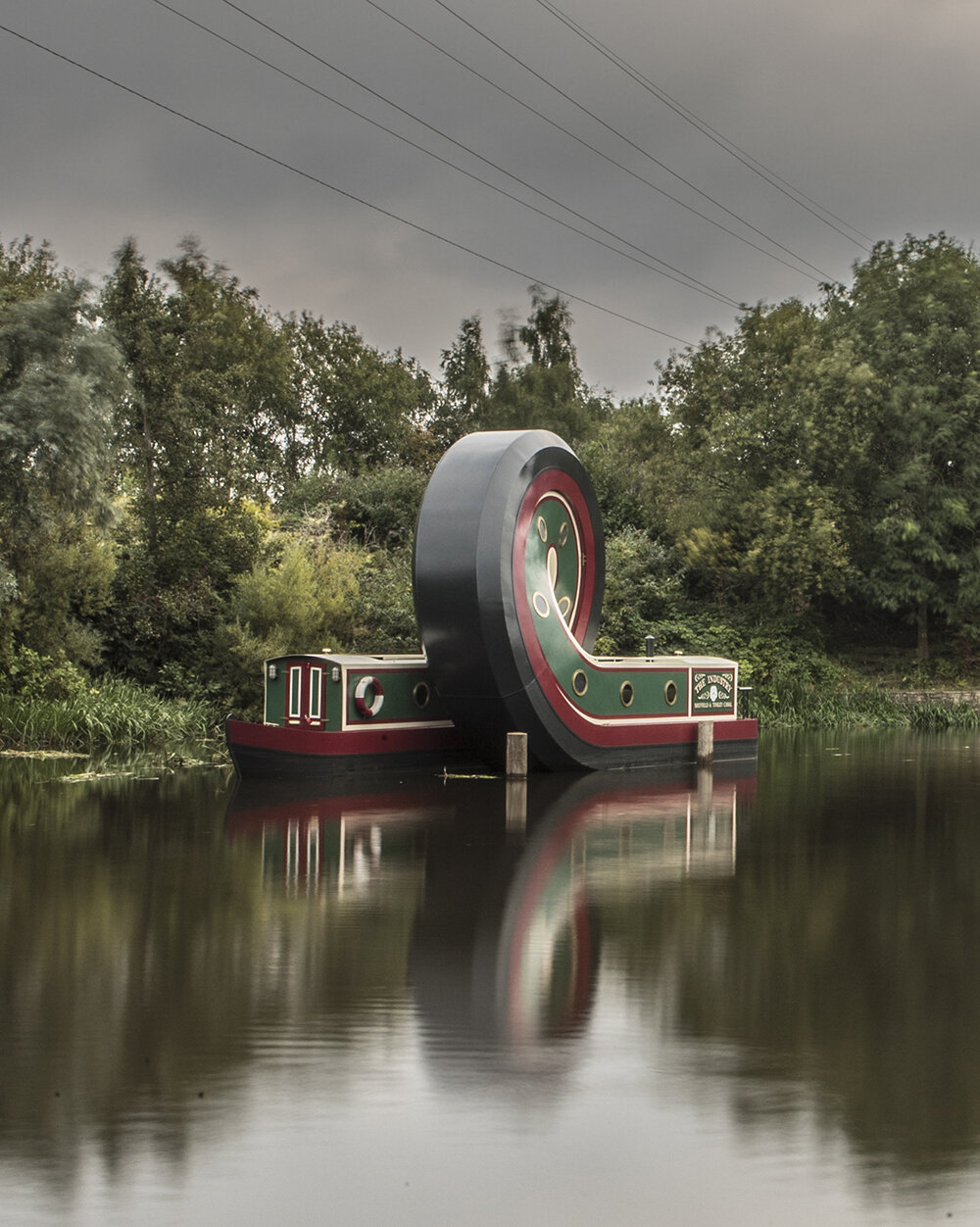
The Looping is now on view at the Sheffield & Tinsley Canal
interview with alex chinneck
designboom (DB): Can you walks us through The Looping Boat and how it ties to the canal’s historical layer?
Alex Chinneck (AC): The project is in Sheffield, an area we’ve worked in for a long time. We took part in an open call about seven or eight years ago and won the commission. The Looping Boat has been underway ever since. When we responded to the open call, we didn’t really commit to a particular design; instead, we explored the idea of it. It’s how we approach all of our work, which is developing an improved understanding of the location. I’ve always championed the idea that the work belongs to its surroundings. We not only consider the aesthetic of the area but also the people that use it and occupy it, the opportunities that the location presents, and the history of the location. I like to think that when something resonates with the past of a place, it’s a good way of connecting with the present and, hopefully, the future.
We spent a lot of time in this particular area of Sheffield, understanding all of those different elements. Along the way, we originally designed a series of four huge sculptures to travel along the canal, which is 200 years old and has an incredible industrial history. It used to be lined with many factories, and it was of hive of industrial activity, production, energy, and community, and that’s all changed now. It’s largely all gone along the canal. What’s left are the remnants of old cranes, old bridges, and old fallen factories. Even with this industrial heritage, it’s also a lovely place to spend time and walk.
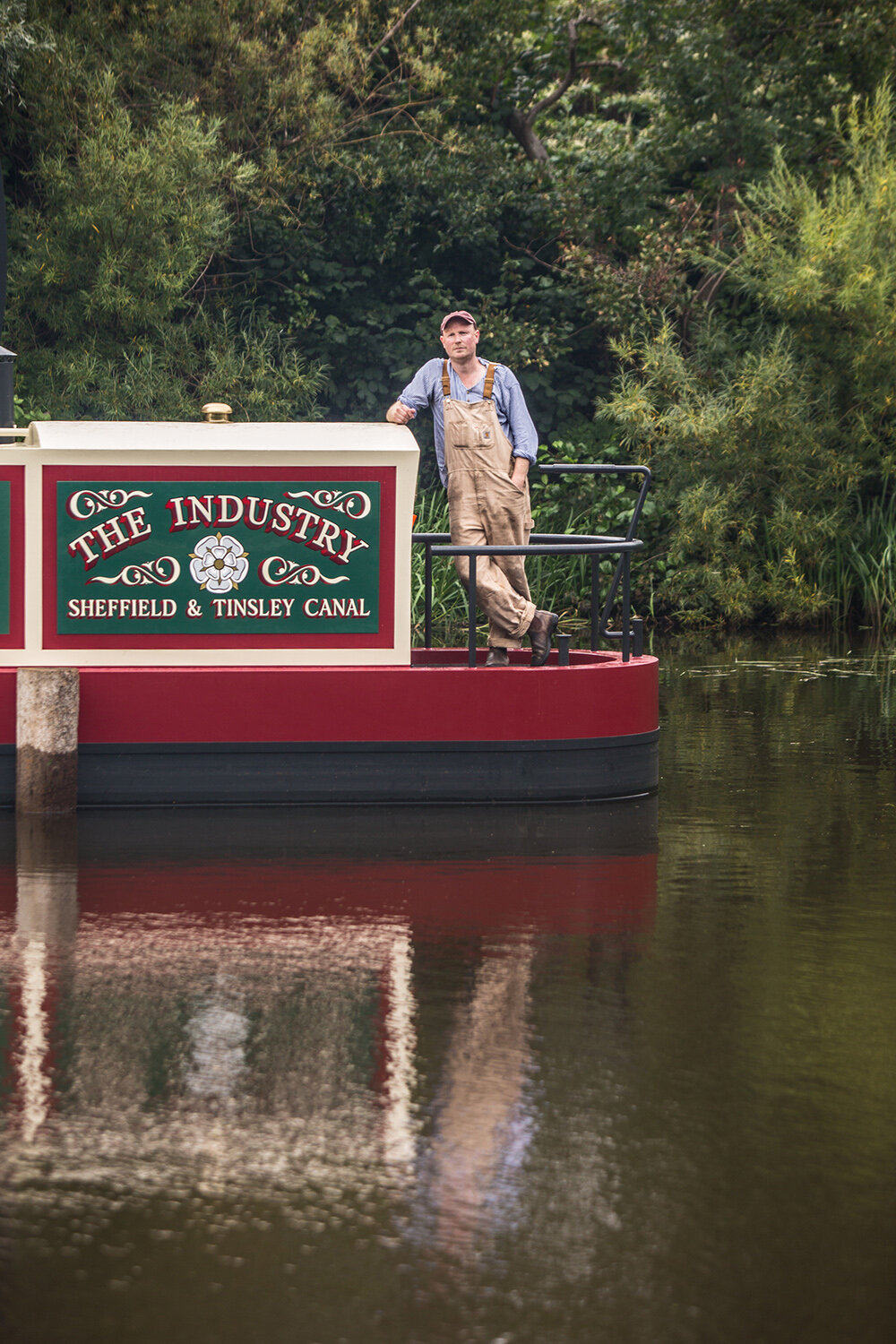
British artist and sculptor Alex Chinneck on The Looping Boat
AC: However, as different issues surfaced, we didn’t end up pursuing the original series of sculptures. Instead, we installed two artworks in Tinsley to engage and hopefully excite the residents, particularly the local school children who would never expect to find a public artwork on their doorstep. The first work is our peeling road, which gives the illusion of a car hanging upside down. We installed that overnight, so everyone woke up in the morning to the sight of it in Tinsley. We also brought every single class from the local school, one at a time, and it did a lovely job of blowing their mind. It had a hefty dose of theatricality. The second artwork is our knotted bronze post boxes outside of the school as well, which they equally loved. So we’ve been working in this part of Sheffield long.
Returning to The Looping Boat, we wanted to take advantage of the heritage and water element. The site’s history of steel and fabrication of factories pushed us to create something out of metal; something that was very complicated to build. And sited very close to the marina, home to other canal boats, the sculpture sits nicely within the landscape and the history; it encourages people to walk along the canal system and discover it. It’s not a plinth, a gallery, or a town square. You have to make a journey to go and see it. It’s very much nestled into its situation, and it’s really unpretentious. While I don’t consider it street art, it has that feel of something that pops up in a surprising way; you would never expect it to be there. I really love that. That’s my favorite kind of public art.
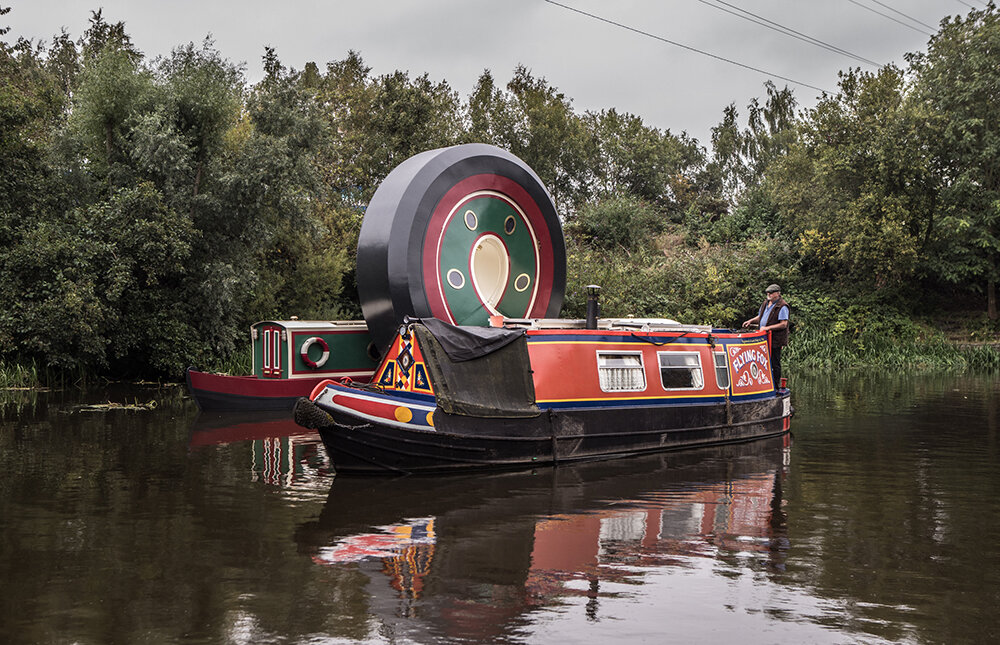
the design reflects traditional canal boat colors
DB: The loop-de-loop is a signature style of yours. Could you elaborate on what it represents in this particular context? Considering the industrial heritage?
AC: I love the illusion of material fluidity, and something about it on the water works so nicely. I find that to be a deeply satisfying sculptural action. And then, obviously, I really enjoy the surrealism of taking ordinary things and making them as extraordinary as possible. In terms of the loop itself, I wouldn’t say it represents anything. I always work in a very sculptural and contextual way. I don’t often operate in an overly conceptual way. That’s how it’s always been, and that approach works well in the public realm. It’s not that it’s intentionally diluted in terms of intellect. It’s just that it isn’t overly communicative of a particular idea or concept, and I think it leaves it more open to enjoyment, access, and interpretation. I’ve always loved loops because there’s this kind of continuation of a journey. I like that you keep going in the same direction, but there’s a complicated and awkward detour along the way, which feels quite true to life.
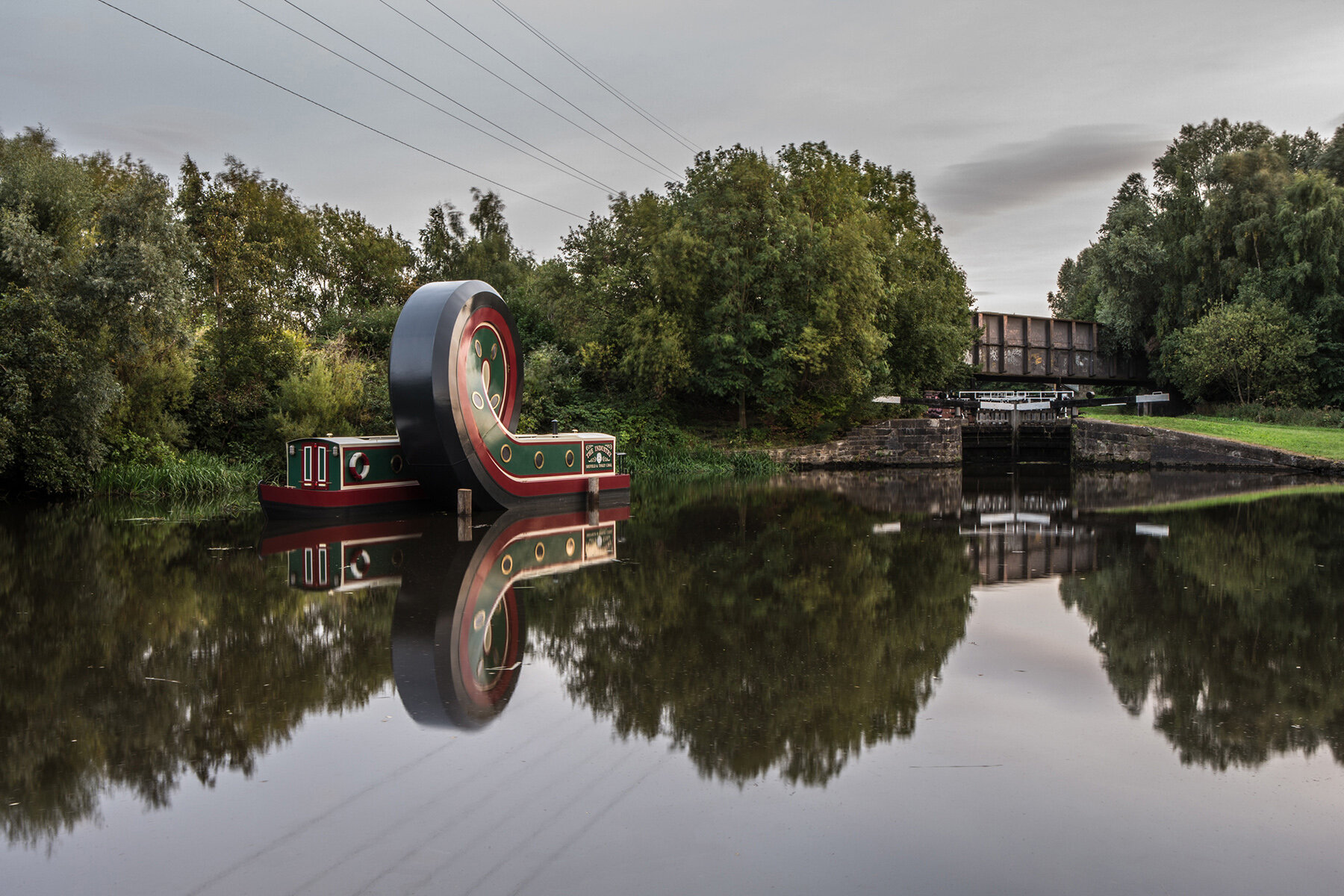
performing a six-meter-high and thirteen-meter-long, gravity-defying, aerial loop-de-loop
DB: The Looping Boat is your most complex project to date. Walk us through the construction process, its complexity, and how it’s influenced your artistic direction.
AC: At the risk of repeating myself, the nice thing about working in the public realm and different locations is the environment and the surroundings; it’s the materials and how the context is always changing. These changes bring about a tweak of the aesthetic, a tweak of the theme, a tweak of the materials, a tweak of the subject matter — whether it’s a pylon, car, boat, etc.. I think all our work is different, but a common sculptural thread still travels through them, essentially a kind of fluidity and surrealism. What’s different here is the chosen shape. In terms of design, we spent a lot of time refining the size, shape, color palette, and detailing. But the engineering part is tricky; building a thirteen-meter long, six-meter high object that goes on the water means we need to make it highly stable. It can’t fall over. We always work with the same engineering team, but given these new challenges, we had to appoint additional experts — namely, engineers who specialize in the waterways.
It got more complicated when we moved on to the logistics. The artwork’s location on the canal makes it impossible to access by vehicle. This lack of vehicle access meant that we will need to transport it along the water and design it in a way that comes apart into sections that would fit under the bridges and through about twenty lock gates. These parts are going to be towed along the water for about two miles before getting assembled on the water by crane. We had to design the entire structure, its size and shape, and the weight of the components around these restrictions. We also had to dredge the canal bed — which means clearing all of the old silt that’s built up at the bottom to make way for the steel pads — and be extra careful about the size of the machines we were using, where they would go, so as not to interfere with the rail and tram lines nearby.
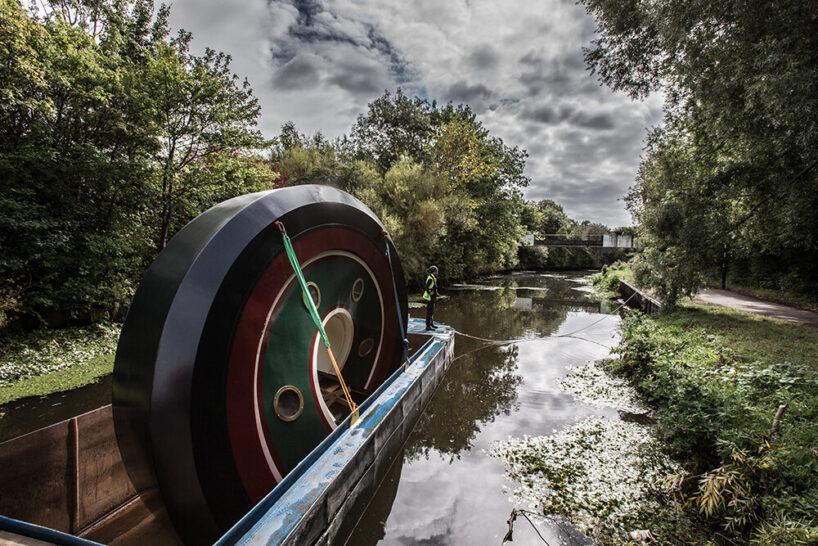
installation process on the canal
AC: But the big one was bombs. This area of the canal was bombed heavily in World War II and became a high-risk location for unexploded devices. It’s rare, but it happens — and it’s incredibly tricky when underwater. We had to commission an underwater radar survey that detected all metal objects lying on the canal bed and assessed their size and shape, the positive and negative poles, and the depth they were at. But identifying the bombs can be highly uncertain; it’s called a ferrous anomaly. So, we had to create clearance radiuses around the objects we couldn’t be sure about and design the entire project away from these zones. That’s why we have a bomb expert on site; we even had to appoint specialist waterway contractors. That’s not all; we also had to deal with contaminated soil, power cables near the water, and coal mines. In my opinion, this is as complicated as public artwork gets.
Despite these challenges, what distinguishes our practice from others is that we genuinely still try to create artworks that haven’t been made before and genuinely try to defy logic. It’s not an easy path but a necessary one to reach an original and unique conclusion. I do think it’s an artist’s responsibility to make this kind of impact on contemporary art. A shot of originalities is critical, and one mechanism for that is doing ridiculously complex projects.
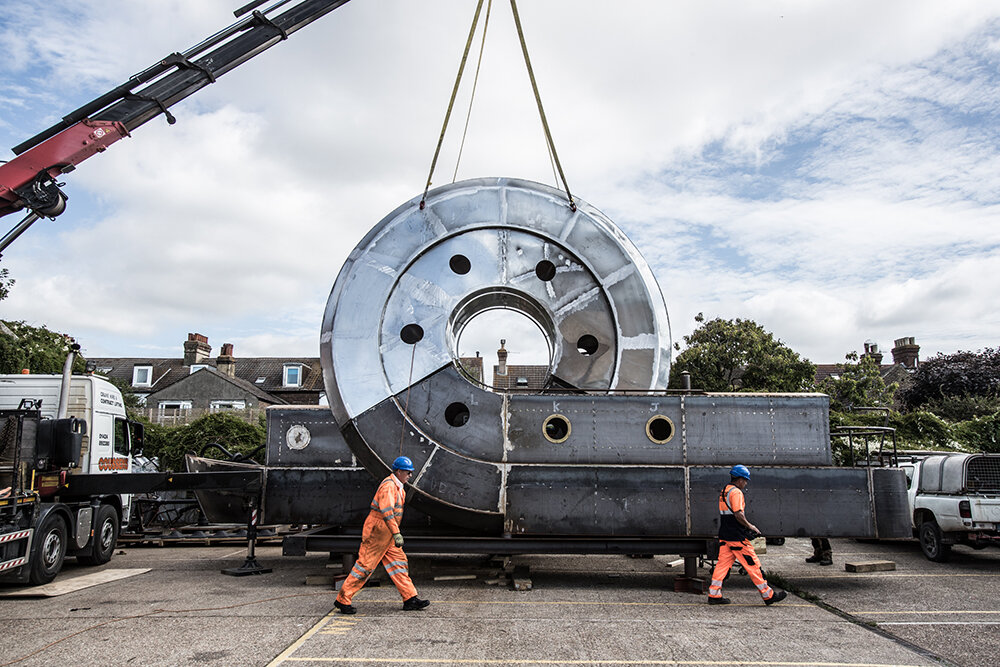
The Looping Boat is made of rolled steel
DB: Building on your previous two installations at Tinsley, and given how The Looping Boat is going to be a permanent artwork, how do you hope this project resonates with the local community? Do you see it eventually evolving into something more?
AC: I certainly hope it encourages more people to go along the waterway and enjoy the artwork and properly take in the site and landscape. The sculpture is part of the site experience. And while The Looping Boat is quite large and complex, I think we worked out a good scale so as not to overpower the context. It’s not too punchy and not too loud. I think it’s fun, accessible, colorful, and cute in many ways. I really hope that people will see it as a warm, uplifting, and contextually responsive little landmark — that it grows into an endearing object. We will hire a bus for a day and take every class from the local schools to see it. I hope that it excites them in the way that the peeling road did. We’re also putting in place a yearly maintenance program so we can return and repaint the sculpture, as it’s designed to last a very long time.
Beyond that, I want us to find a way of telling the story of The Looping Boat. It’s not just about the finished product but also about how we got there and the challenges you meet along the way. That’s why we’re partnering with the Canal and River Trust, a charity that owns and manages the waterway, to include this story on their website. And then, eventually, I hope to write books about it and see documentaries made for it.
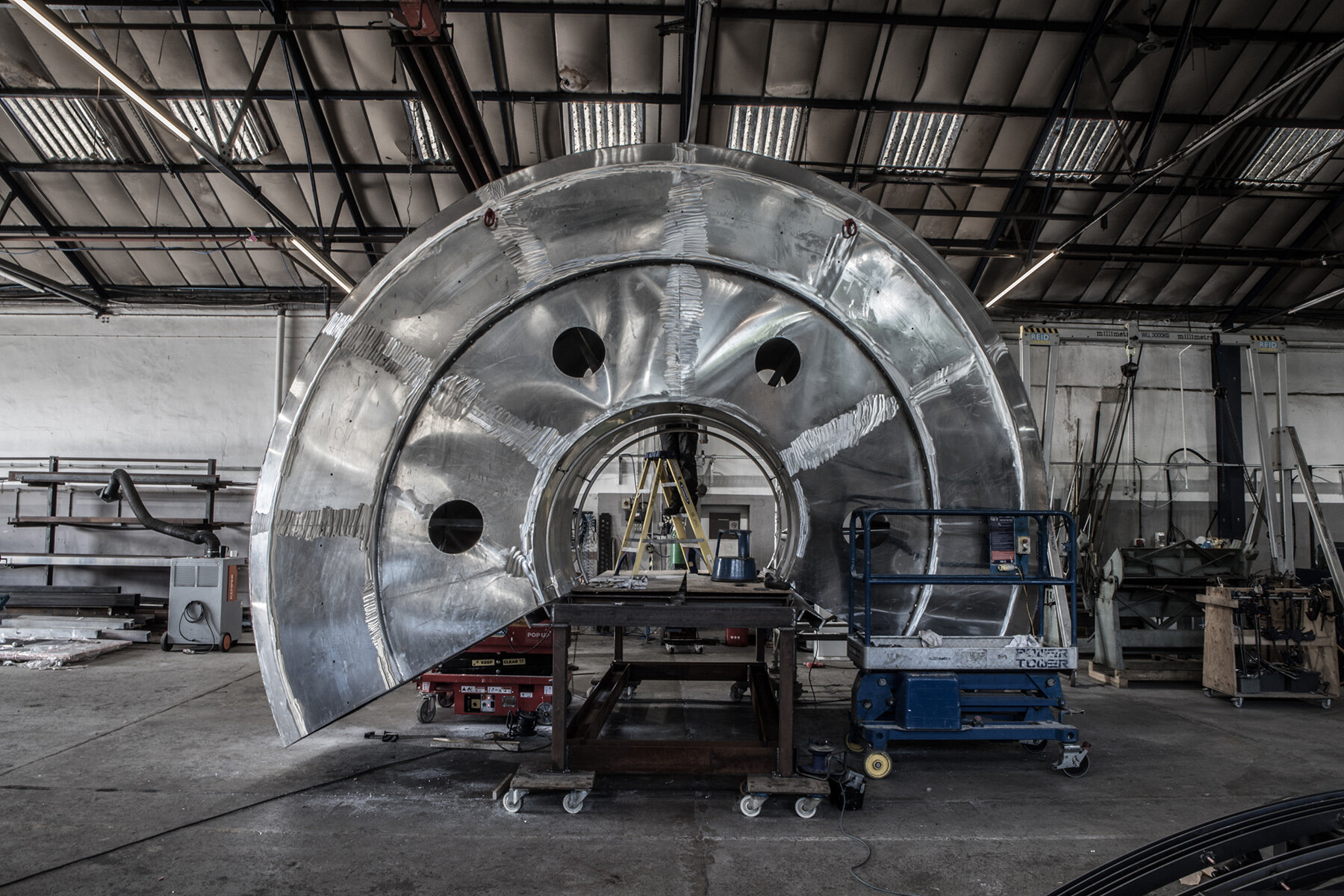
DB: The Looping Boat is quite a straighforward title for a project, unlike your previous ones which are known to have quirky and playful names…
AC: I’ll give you a real exclusive. We’re still figuring out what to call it, behind-the-scenes (laugh). One of our better-known projects is the sliding house, and everyone calls it the sliding house. But the real title is: From the Knees of my Nose to the Belly of my Toes. We kind of anticipated this, and it’s absolutely fine. The same goes for this project; everyone will call it The Looping Boat because that’s what it will be. Even though we don’t really use those quirky names, I still enjoy the titling process. It’s a nice way to put a bow around the work as if we’re wrapping it up before moving on to the next thing.
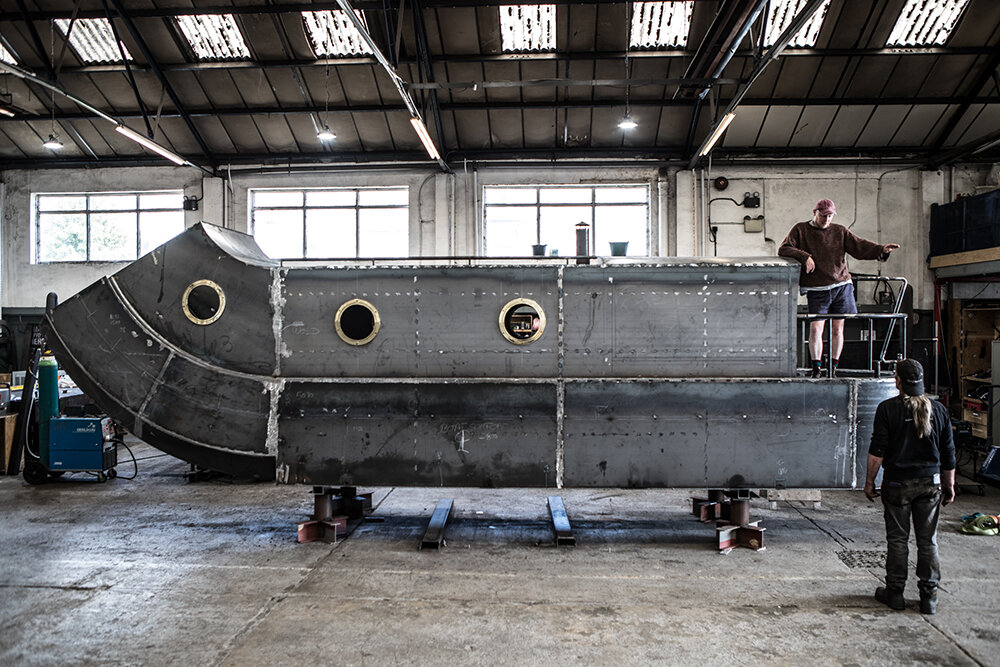
fabrication process
DB: Looking ahead, what material(s) or technique(s) would you like to to start / keep experimenting with?
AC: For about four years, we turned things upside down, we cracked them, and melted them; it was a great hive of sculptural experimentation. Then, during the pandemic, something changed; we wanted to focus on one sculptural area: the illusion of fluidity, as seen with our bending and unzipping buildings, our knots, our twists, our loop-de-loops. We wanted to establish a strong visual identity and strong association with that sculptural form. And it’s been a great journey for us. But now we’re looking to dive deeper into kinetic works, like our Hermès windows, which I say is a nice vehicle to move some of those ideas further. It’s a lovely platform to test ideas on a small scale before applying them to an architectural situation. We’ve already started to fold buildings like origami.
And now that we understand processes more, we can work with more challenging elements like cast iron and bronze. We’ve gotten to a nice point where our material palette and our technical understanding of what’s possible is as broad as it’s ever been, and the appetite and the opportunity to create lots of different types of work — bending, cracking, moving — is as good as it’s ever been. In the next 12 months, our practice is going to start to move in lots of new directions, which is really exciting.
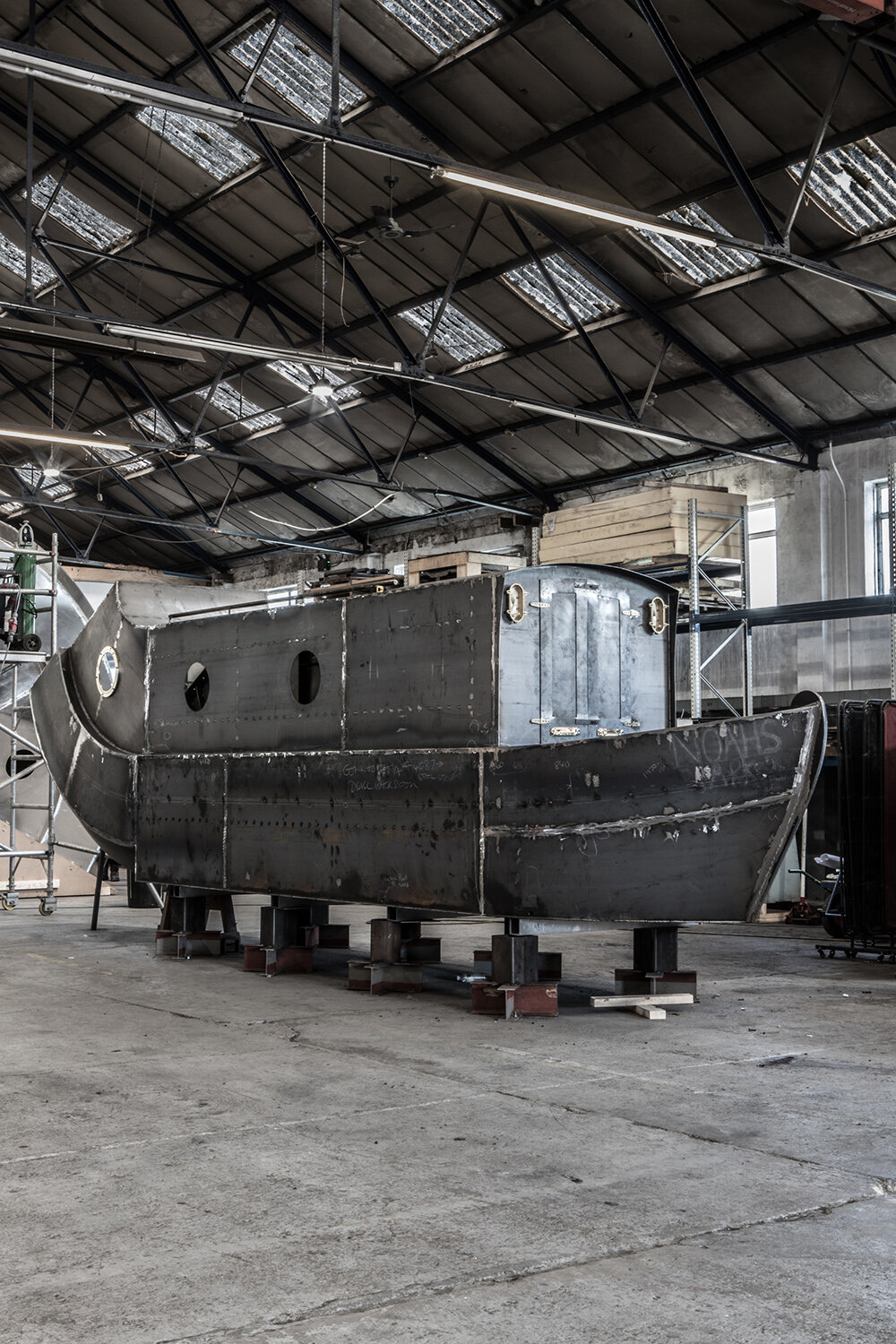
the sculpture is designed as parts to be assembled on-site
DB: Beyond Sheffield, where do you see your work landing in?
AC: We were thinking that it would be great to have a project in Dubai. There’s some energy there in terms of public art. Our work enjoys quite a large international reach, which is great, but, so far, our interventions had been confined to places in the UK and Europe. We’ve never made a public artwork in America or the UAE. That’s definitely something worth uncovering.
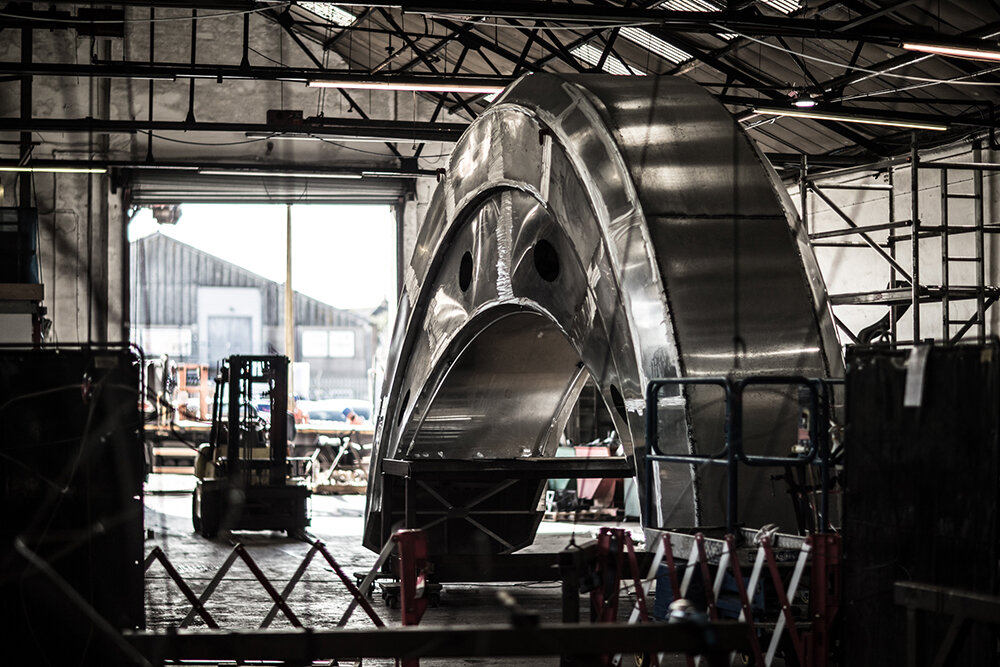
Alex Chinneck describes this project as his complex to date
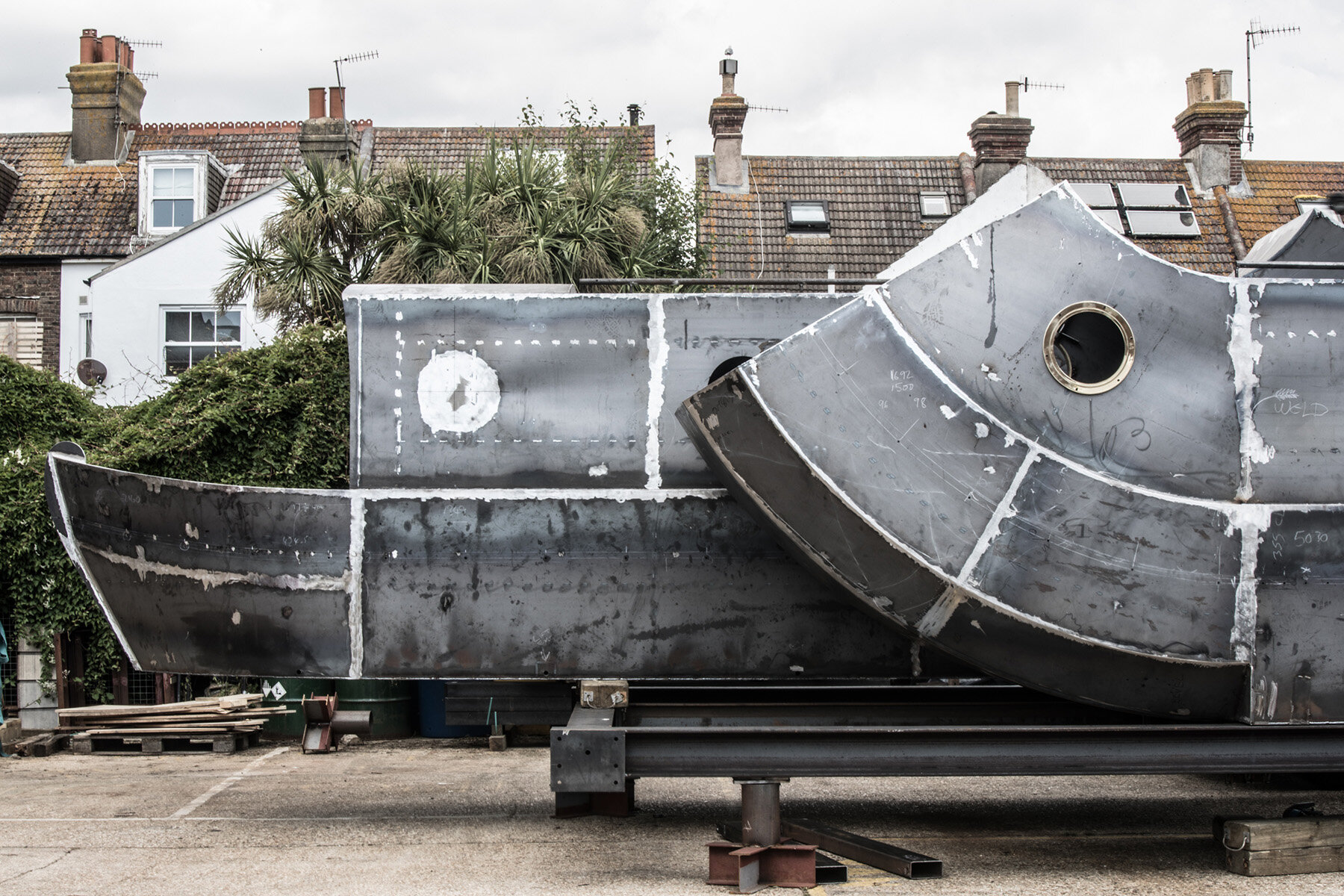
detail shot of The Looping boat in fabrication
project info:
name: The Looping Boat
artist: Alex Chinneck | @alexchinneck
location: Sheffield & Tinsley Canal, UK
co-funded by: British Land and E.ON
photographer: Marc Wilmot
launch date: September 2024
height: 6 meters
length: 13 meters
happening now! thomas haarmann expands the curatio space at maison&objet 2026, presenting a unique showcase of collectible design.
